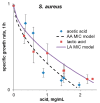A Study on the Synbiotic Composition of Bifidobacterium bifidum and Fructans from Arctium lappa Roots and Helianthus tuberosus Tubers against Staphylococcus aureus
- PMID: 33926121
- PMCID: PMC8146412
- DOI: 10.3390/microorganisms9050930
A Study on the Synbiotic Composition of Bifidobacterium bifidum and Fructans from Arctium lappa Roots and Helianthus tuberosus Tubers against Staphylococcus aureus
Abstract
A number of mechanisms have been proposed explaining probiotics and prebiotics benefit human health, in particular, probiotics have a suppression effect on pathogen growth that can be enhanced with the introduction of prebiotics. In vitro models enhanced with computational biology can be useful for selecting a composition with prebiotics from new plant sources with the greatest synergism. Water extracts from burdock root and Jerusalem artichoke tubers were purified by ultrafiltration and activated charcoal and concentrated on a rotary evaporator. Fructans were precipitated with various concentrations of ethanol. Bifidobacterium bifidum 8 VKPM AC-2136 and Staphylococcus aureus ATCC 43300 strains were applied to estimate the synbiotic effect. The growth of bifidobacteria and staphylococci in monocultures and cocultures in broths with glucose, commercial prebiotics, as well as isolated fructans were studied. The minimum inhibitory concentrations (MICs) of lactic and acetic acids for the Staphylococcus strain were determined. A quantitative model joining the formation of organic acids by probiotics as antagonism factors and the MICs of pathogens (as the measure of their inhibition) was tested in cocultures and showed a high predictive value (R2 ≥ 0.86). The synbiotic factor obtained from the model was calculated based on the experimental data and obtained constants. Fructans precipitated with 20% ethanol and Bifidobacterium bifidum have the greater synergism against Staphylococcus.
Keywords: Bifidobacterium bifidum; Jerusalem artichoke tubers; Staphylococcus aureus; burdock roots; coculture; fructans; growth inhibition model; synbiotics.
Conflict of interest statement
The authors declare no conflict of interest.
Figures



References
-
- Basu S., Mukherjee M. Reference Module in Materials Science and Materials Engineering. Elsevier; Amsterdam, The Netherlands: 2018. Natural Products and Their Role to Combat Microbial Infection.
-
- Parastan R., Kargar M., Solhjoo K., Kafilzadeh F. Staphylococcus aureus biofilms: Structures, antibiotic resistance, inhibition, and vaccines. Gene Rep. 2020;20:100739. doi: 10.1016/j.genrep.2020.100739. - DOI
-
- Smelov V., Naber K., Johansen T.E.B. Improved Classification of Urinary Tract Infection: Future Considerations. Eur. Urol. Suppl. 2016;15:71–80. doi: 10.1016/j.eursup.2016.04.002. - DOI
Grants and funding
LinkOut - more resources
Full Text Sources
Molecular Biology Databases

